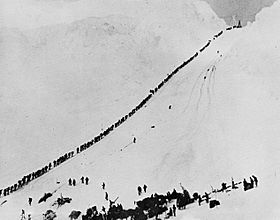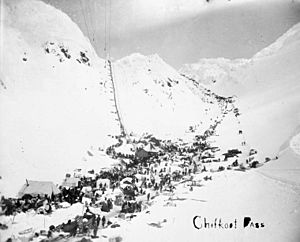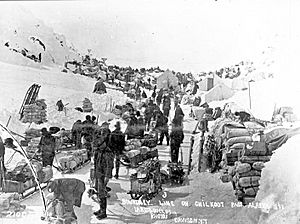Chilkoot Pass facts for kids
Quick facts for kids Chilkoot Pass |
|
|---|---|

Miners and packers climbing the Chilkoot Pass, September 1898, during the Klondike Gold Rush
|
|
| Elevation | 3,759 ft (1,146 m) |
| Traversed by | Chilkoot Trail |
| Location | United States: Municipality of Skagway Borough, Alaska Canada: Atlin District, British Columbia |
| Range | Boundary Ranges |
| Coordinates | 59°41′49″N 135°14′19″W / 59.69694°N 135.23861°W |
| Topo map | NTS 104M11 |
The Chilkoot Pass is a high mountain pass located in the Boundary Ranges of the Coast Mountains. It sits on the border between Alaska in the United States and British Columbia, Canada. The pass is 3,759 feet (1,146 meters) high.
It is the highest point along the famous Chilkoot Trail. This trail goes from Dyea, Alaska to Bennett Lake, British Columbia. For a long time, the Tlingit people used the Chilkoot Trail for trading.
Later, during the Klondike Gold Rush in the late 1800s, many gold seekers used this pass. They were called "stampeders." They used it to travel through the mountains to reach the gold fields. To help with the journey, some aerial tramways and hoists were built over the pass.
However, when the White Pass and Yukon Route Railroad was built nearby, the Chilkoot Pass became less popular. Today, the Chilkoot Pass and Trail are protected by national park services in both the U.S. and Canada. Visitors can still hike the 33-mile trail after registering and paying a fee.
Contents
Why was Chilkoot Pass so important?
The Klondike Gold Rush started on August 16, 1896, in an area called Bonanza Creek. This was near Dawson, about 50 miles east of the Alaskan border. The Chilkoot Trail was the main path to get there. It stretched about 28 to 33 miles from the sea at Dyea, Alaska to Lake Bennett, British Columbia.
The Chilkoot Pass was a huge challenge for gold seekers. To enter the Klondike, Canadian officials made a strict rule. Each person had to bring one ton (about 900 kg) of supplies with them. This was to make sure they had enough food and gear to survive. Half of the weight was food for a year, and the rest was equipment.
The list of required items was very long. It included things like a waterproof blanket, wool socks, flannel shirts, and a medicine kit. Food items included rolled oats, flour, salt, and bacon. The weight of each item varied greatly. This rule was taken seriously because returning from the Klondike was very difficult.
Today, park officials still require hikers to prepare well for the trail. However, modern technology means the supply list is much shorter. Hikers can now bring lighter gear, like lightweight camp stoves.
Carrying supplies over the pass
No traveler could carry all their supplies at once. They had to make many trips to move everything to their destination. Often, they carried packs weighing 50-60 pounds (23-27 kg) by hand. The trails were too narrow for wagons or animals in many places.
Travel was very slow. What might take a few hours in an easy environment took days on the Chilkoot Trail. It's thought that for every mile their supplies moved, travelers had to walk 80 miles to get them there.
Only the richest gold seekers could pay others to carry their supplies. Most had to carry their own. Professional packers were mainly Alaska Natives and First Nations people. They charged about 1 cent per pound carried. Their fees could change depending on the weather and ground conditions. Muddy ground was much harder to cross than frozen, snow-covered ground.
What was the Chilkoot Pass like?
The Chilkoot Trail climbed 900 feet (274 meters) to the base of the Chilkoot Pass. This area was called "The Scales." It was a rocky place named because it was the last spot where travelers could reweigh their packs. They could also store supplies here before bringing up the rest of their gear.
After The Scales, the ground rose steeply about 500-600 feet (150-180 meters) over half a mile. The trail was covered with large, sharp rocks. This made walking very difficult, and people often had to crawl in the summer.
In winter, workers carved about 1,500 steps into the ice. These steps became known as the "Golden Stairs." The steps were narrow, so only one person could climb at a time. This created a long, single-file line up the mountain. The workers who carved the steps also charged travelers to use them.
Tramways made travel easier
Ropes were put along the trail to help travelers keep their balance on the slippery slopes. After 1897, a tramway was built. This allowed wealthy travelers to move their goods the last 600 feet (183 meters) up the Pass more easily. Two horses powered the tramway. It cost 1.5 cents per pound to use. The person who built the tramway was said to earn about $150 per day!
On the other side of the Pass was Emerald Lake. Going down the mountain meant a drop of 1,300 feet (396 meters) over about 9 miles (14.5 km). The top of the mountain and the path down often had snow all year, making the journey even harder.
Dangerous weather
The Chilkoot Pass had a high risk of avalanches. Snowstorms were common, and heavy snow could slide down the mountain. Avalanches could trap many people at once. Despite the danger, travelers kept using this pass because it was the cheapest and shortest way to move their supplies.
The weather on the Pass was very unpredictable. Visibility could drop to just a few feet. Travelers often got soaked from rain and sweat. The sun reflecting off the snow could also cause severe sunburn and temporary blindness.
North West Mounted Police on the border
At both the Chilkoot Pass and the White Pass, members of the North West Mounted Police (NWMP) were stationed. Their job was to collect customs duties on goods brought into Canada. They also protected supplies. Since gold seekers had to leave some of their goods behind during their trips, the police made sure the right items went to the right person. They also enforced the rule that each person had to bring one ton of goods.
There were some disagreements between the NWMP and Americans about where the international border was. After discussions, the governments decided to keep the border at the Chilkoot and White Passes. The NWMP had already built customs houses at both passes before this was settled. Canada also used its soldiers, called the Yukon Field Force, to help the NWMP. They guarded prisoners and protected gold shipments. The NWMP also controlled the sale of alcohol along the trails.
The police wanted to build a proper entry point at the top of both passes. This would help secure the border. Building a cabin on the Chilkoot Pass summit was difficult and expensive. The wood had to be brought up by tramway. The cabin itself was not built well. Strong winds blew snow inside, and when it melted, everything became wet and moldy. Blankets and bedding would not dry. Despite the poor conditions, collecting customs duties on the Chilkoot Pass summit began on February 26, 1898.
Women on the trails
With rumors of gold, many men and women saw the Gold Rush as a chance to get rich. Historians believe about 1,500 women traveled the Chilkoot and White trails. This was about seven percent of all travelers between December 1898 and September 1900.
At the start of the gold rush, only a few hundred non-native women participated. Some were wives of gold seekers. Others traveled to find jobs as clerks, teachers, cooks, or nurses. It was even reported that a woman doctor worked at Camp Lindeman.
The clothing women wore at the time made their journeys very difficult. Long, full skirts were not practical for hard physical work. They were often made with five or more yards of fabric, making them heavy. Corsets and petticoats also limited their movement. High collars meant women had to hold their heads high.
Because of the tough conditions, many women stopped wearing traditional clothing. They started wearing "bloomers" or "knickers." These were long, full pants gathered at the ankle or below the knees. Women often wore shorter skirts over these bloomers, usually knee-length. This was seen as controversial by some men, but it was more accepted than not wearing skirts at all. Some women who went to the Klondike left their children behind. Few wanted their children to face the dangers of the trails.
Another way to the gold fields
The trail from Skagway, Alaska to White Pass and Lake Lindeman was another option. However, this route had its own dangers. A criminal named Soapy Smith and his gang operated in Skagway. They were known for cheating and stealing from travelers. They would even harm people who got in their way.
The White Pass trail became very narrow and difficult. A large rock, caused by dynamite from above, fell on a married couple and their horses. They were buried, and the rock remains there today. It is marked with a black Christian cross and is known as Black Cross Rock.
This pass became too narrow for wagons. Men still tried to use horses, but many had no experience with animals. They often pushed the horses too hard, leading to their deaths. Men would shoot horses that couldn't go on, or just leave them to die in the mud and snow. This was so common that a part of White Pass was called "Dead Horse Trail." Many men would go back to the beach to buy more horses.
Most horses died within a two-mile stretch of the White Pass trail. By 1897, 3,200 pack horses had died there. Their bodies were left on the trail, sometimes used as footing for other horses. Horses that had fallen were not always dead and suffered more under the hooves of others.
When horses could no longer work on the Chilkoot Trail, they were often set free without food. Many were left at Sheep Camp, at the base of Chilkoot Pass. Most of these animals became sick and starved as they searched for food. They were no longer useful and had lost their value.
Many travelers on both the Chilkoot and White Pass Trails suffered from a lack of food. Some even died from it. It was rumored that one traveler boiled his boots to make broth so he would have something to eat. Besides physical sickness, some people also struggled with their mental health due to the harsh conditions. Historians suggest this was caused by poor diets and the extreme cold. The only shelter against temperatures as low as -40 degrees Fahrenheit (-40 degrees Celsius) were thin tents.
In culture
"Take the oath again, Daylight," the same voice cried. "I sure will. I first come over Chilkoot in '83. I went out over the Pass in a fall blizzard, with a rag of a shirt and a cup of raw flour. I got my grub-stake in Juneau that winter, and in the spring I went over the Pass once more. And once more the famine drew me out. Next spring I went in again, and I swore then that I'd never come out till I made my stake. Well, I ain't made it, and here I am. And I ain't going out now. I get the mail and I come right back. I won't stop the night at Dyea. I'll hit up Chilkoot soon as I change the dogs and get the mail and grub. And so I swear once more, by the mill-tails of hell and the head of John the Baptist, I'll never hit for the Outside till I make my pile. And I tell you-all, here and now, it's got to be an almighty big pile."
—Jack London, Burning Daylight (1910)
See also
 In Spanish: Paso de Chilkoot para niños
In Spanish: Paso de Chilkoot para niños




